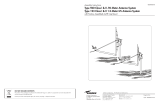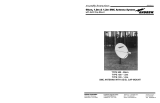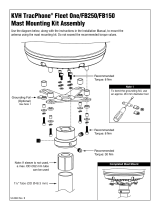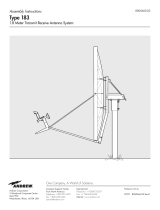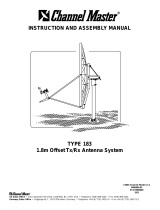Page is loading ...

Printed in China
07/09 8001025-01 Rev C
RavenSkyware
1315 Industrial Park Drive
Smithfield, NC 27577
Telephone: +1-919-934-9711
Internet: www.raven.co.uk
Assembly Instructions
Type 122 1.2 Meter Class I Antenna System
with Precision Az/El Cap Mount
8001025-01

1
DATE DESCRIPTION REVISION
4/09 5080545 Rev A
6/09 Rev B
7/09 574 Rev C
MANUAL REVISION HISTORY
DO NOT DISCARD CONTENTS
The product in this packaging was placed in the market after August 13, 2005. Its components must not be discarded with
normal municipal or household waste.
Contact your local waste disposal agency for recovery, recycling, or disposal instructions.
LAW: Installation and installer must meet local codes and ordinances regarding safety! Installation of this product should be performed only
by a professional installer and is not recommended for consumer Do-It-Yourself installations.
DANGER: WATCH FOR WIRES! Installation of this product near power lines is extremely dangerous and must never be attempted. Installa-
tion of this product near power lines can result in death or serious injury! For your own safety, you must follow these important safety rules.
Failure to follow these rules could result in death or serious injury
1. Perform as many functions as possible on the ground
2. Watch out for overhead power lines. Check the distance to the power lines before starting installation. Stay at least 6 meters (20 feet)
away from all power lines.
3. Do not install antenna or mast assembly on a windy day.
4. If you start to drop antenna or mast assembly, move away from it and let it fall.
5. If any part of the antenna or mast assembly comes in contact with a power line, call your local power company. DO NOT TRY TO
REMOVE IT YOURSELF! They will remove it safely.
6. Make sure that the mast assembly is properly grounded.
WARNING: Assembling dish antennas on windy days is extremely dangerous and must never be attempted. Due to the surface area of the
reflector, even slight winds create strong forces. For example, this antenna facing a wind of 32 km/h (20 mph) can undergo forces of
269 N (60 lb). BE PREPARED TO SAFELY HANDLE THESE FORCES AT UNEXPECTED MOMENTS. ATTEMPTING TO ASSEMBLE, MOVE OR
MOUNT A DISH ON WINDY DAYS COULD RESULT IN DEATH OR SERIOUS INJURY. Raven is not responsible or liable for damage or injury
resulting from antenna installations.
WARNING: Antennas improperly installed or installed to an inadequate structure are very susceptible to wind damage. This damage can
be very serious or even life threatening. The owner and installer assumes full responsibility that the installation is structurally sound to sup-
port all loads (weight, wind and ice) and properly sealed against leaks. Raven will not accept liability for any damage caused by a satellite
system due to the many unknown variable applications.
WARNINGS
PRE INSTALLATION CONSIDERATIONS
TOOLS REQUIRED:
Compass 13 mm Deep Socket (3/8” Drive) 10 mm Nut Driver Torque Wrench
Clinometer #1 or #2 Phillips Screwdriver 10 mm Socket (3/8” Drive) 9” Magnetic Level
3/8” Drive Ratchet Wrench 13 mm Combination Wrench 10 mm Combination Wrench
ADDITIONAL INSTALLATION MATERIALS (Not Included with Antenna System)
Installation Mount (Ground Pole, King Post, Wall Mount or Roof Mount)
Grounding Rod, Clamp & Grounding Block - As required by National Electric Code or local codes.
Ground Wire - #10 solid copper or #8 aluminum as required by National Electric Code or local codes (length as required).
RG-6 Coaxial Cables from antenna to indoor units.
Concrete: See “Ground Pole” section for quantity
M10 or #3 Rebar: See “Ground Pole” section for quantity. Deformed steel per ASTM A615, Grade 40 or 60.

2
SITE SELECTION
The first and most important consideration when choosing a prospective antenna site is whether or not the area can provide an acceptable
“look angle” at the satellites. A site with a clear, unobstructed view is preferred. Also consider any obstruction that may occur in the future
such as the growth of trees. Your antenna site must be selected in advance so that you will be able to receive the strongest signal available.
To avoid obstructions, etc., conduct an on-site survey with a portable antenna. The satellite antenna can be installed on a ground pole, wall/
roof mount, or non-penetrating roof mount with 2-7/8” or 3” outside diameter mast. The chosen mount type should be assembled and in
place before installing the antenna. Refer to instructions packed with mount for its proper installation. The mast pipe must be vertical and
plumb to insure ease of alignment.
As with any other type of construction, a local building permit may be required before installing an antenna. It is the property owner’s
responsibility to obtain any and all permits.
Before any digging is done, information regarding the possibility of underground telephone lines, power lines, storm drains, etc., in the
excavation area should be obtained from the appropriate agency.
Because soils vary widely in composition and load capacity, consult a local professional engineer to determine the appropriate foundation
design and installation procedure. A suggested foundation design with conditions noted is included in this manual for reference purposes
only.
GROUND POLE INSTALLATION
7.3 cm or 7.6 cm
(2.88” or 3.00” O.D.)
91.4 cm max.
(36”)
182.9 cm
(72”)
102 cm
(40”)
#3 rebar
x diameter
of pier. Insert through
hole in tube and center.
#3 Rebar
D
Minimum
Diameter
25 mm
to 51 mm
(1” to 2”) slope
for water run-off
Grade
Below
Frost Line
182.9 cm
(72”)
25 mm to 51 mm (1” to 2”)
slope for water run-off
Grade
7.3 cm or 7.6 cm
(2.88” or 3.00” O.D.)
D
Minimum
Diameter
Below
Frost Line
Approx.
51 mm
(2”)
127 cm
(50”) (See Note)
#3 rebar x .46 m (18”)
Insert through
hole in tube and center.
#3 Rebar
#3 rebar x .6 m (24”)
at 60˚ apart (See note)
51 mm
(2”)
Bubble
Level
Ground Pole Must Be
Vertical in All Directions
at Top
NOTE:
127 cm (50”) may
be increased to frost
line. Concrete and
length of rebar will
increase
accordingly.
Bottom View
91.4 cm max.
(36”)
Pier Foundations Deep Frost Line Foundations
1.2 m
Antenna
Pier Foundations Deep Frost Line Foundations
WIND VEL DIME D CONC VOL DIM D CONC VOL DIM D CONC VOL DIM D CONC VOL GROUND
km/h (mph) cm (in) m
3
(ft
3
) cm (in) m
3
(ft
3
) cm (in) m
3
(ft
3
) cm (in) m
3
(ft
3
) POLE
161 (100) 30 (12) 0.08 (2.9) 46 (18) 0.18 (6.5) 20 (8) 0.05 (1.6) 33 (13) 0.12 (4.2) A ,B or C
201 (125) 43 (17) 0.17 (5.9) 61 (24) 0.33 (11.5) 30 (12) 0.10 (3.6) 48 (19) 0.25 (9.0) C
EXPOSURE B
EXPOSURE C
EXPOSURE B
EXPOSURE C
POLE SPECIFICATIONS:
Ground Pole “A” 2-1/2 Schedule 40 Steel ASTM A53 Pipe (73 mm x 5 mm Wall/2.88” OD x .203” Wall)
Ground Pole “B” 3.0” OD x 9 Gauge (.148” Wall) Steel ASTM A501 Pipe (76 mm OD x 3.8 mm Wall)
Ground Pole “C” 2-1/2 Schedule 80 Steel ASTM A53 Pipe (73 mm x 7 mm Wall/2.88” OD x .276” Wall)

3
NOTE:
1. Poles are not supplied (purchase locally to above specifications) and must be field drilled 5/8” diameter
for M10 #3 rebar, drilled 5.55 mm
(.218”) for 1/4-20 self tapping grounding screw and galvanized or painted for protection.
2. Pole and foundation design based on the following criteria:
a. Uniform building code Exposure B or C wind loading.
b. Vertical soil pressure of 13790 kPa (2000 pounds per square foot).
c. Lateral soil pressure of 2758 kPa (400 pounds per square foot).
d. Concrete compressive strength of 17.2 MPa (2500 pounds per square inch) in 28 days.
3. See page 6 for grounding recommendations.
CAUTION: The foundation design shown does not represent an appropriate design for any specific locality. Soil conditions vary and may
not meet design criteria given in Note 2. Consult a local professional engineer to determine your soil conditions and appropriate foundation.
ASSEMBLY AND INSTALLATION
Installing Az/El Cap Mount Onto Pole
The az/el cap is factory pre assembled. No assembly is required. Before installing az/el cap onto pole, installation mount should be in place.
Loosen (3) az/el locking nuts on pipe clamp. Install az/el cap onto pole. If using 2 7/8” ground pole, ensure that the inner sleeve is inserted
and that the open side is aligned with the open side of the pipe clamp (see Bottom View). If using 3.00” ground pole, remove inner sleeve on
pipe clamp and discard it. Position the az/el cap in approximate azimuth setting and equally tighten (3) clamp nuts so that cap is held
stationary on pole, but can be swiveled with slight pressure. Tighten to approximately 2.7 N-m (2 ft-lb ).
Back View
Square Nut (Factory Preset)
Square Nut
(Factory Preset)
Azimuth
Locking
Hex Nut
Bottom View
Azimuth
Locking
Hex Nut
Azimuth
Locking
Hex Nut
Open
Side of
Inner
Sleeve
Open
Side
of Pipe
Clamp
Detail of Pipe Clamp
and Inner Sleeve
Note: Pipe Clamp and
Inner Sleeve Should
be Aligned as Shown
Hex
Clamp Nut
(3 Places)

4
ANTENNA ALIGNMENT PROCEDURE
Satellite Alignment
Alignment with the satellite is obtained by setting polarization, elevation, and azimuth. Charts are provided in this manual to determine the
values for your earth station antenna site. “∆L” is the difference between the earth station antenna site longitude and the satellite longitude.
Use “∆L” and your earth station latitude to obtain polarization, elevation or azimuth setting.
Polarization of Feed
Refer to instructions packed with feed assembly.
Elevation - Initial Setting
Use Chart 2 and determine your elevation setting. Loosen
elevation locking bolts, located in curved slots, on both sides.
Turn elevation adjustment bolt clockwise to decrease elevation
or counterclockwise to increase elevation. Position the elevation
alignment arrow with the appropriate mark on the housing at the
desired elevation reading. Scale is in 1 degree increments. This
will be an approximate setting. Snug tighten elevation locking
bolts. (Finger tighten only).
Elevation Locking
Bolts (Both Sides)
Elevation
Adjustment
Bolt
Elevation Alignment
Arrow
Azimuth - Initial Setting
Refer to the azimuth value determined on
chart 3. Values in chart must be adjusted
for magnetic deviation for your location
for correct compass reading. Rotate the
reflector and az/el mount, on the pipe,
pointing it to the compass reading for
your location and satellite. Sweep in
azimuth for signal. If desired signal is not
located, increase or decrease elevation
setting and repeat the azimuth sweep.
Tighten progressively (1/8 turn each) all
three pipe clamp nuts. Repeat until 24
N-m (18 ft-lb) torque is reached.
Square Nut (Factory Preset)
Square Nut
(Factory Preset)
Azimuth
Locking
Hex Nut
Az/El Cap Mount
Bottom View
Rotate Antenna
On Ground Tube
Azimuth
Example Depicts Azimuth Heading To 171˚
(Azimuth ± Magnetic Deviation)
Compass
Azimuth
Locking
Hex Nut
Elevation and Azimuth Fine Tuning
Loosen (3) azimuth locking nuts. Note that the square
nuts are factory preset, and should not be loosened or
tightened. Turn the azimuth fine tune bolt clockwise or
counterclockwise for azimuth fine tuning.
Use a signal strength measuring device to obtain
the most accurate alignment and maximum antenna
performance. Alternate between elevation and azimuth
fine tuning to reach maximum signal strength, until
no improvement can be detected. Tighten and torque
all hardware, alternating sequence, until all bolts are
equally torqued to 24 N-m (18 ft-lb).
Elevation
Fine Tuning
Azimuth
Fine Tuning
Azimuth
Locking
Hex Nut

GROUNDING PROCEDURE
INSTALLATION POLE MOUNT
TRIMAST WALL MOUNT
Non Penetrating
Roof Mount
Ground Wire
Ground Wire
with Ring Clip
Ground
Lug
1/4”
Drilling
Screw
Tooth
Washer
Tooth
Washer
Ground Wire
with Ring Clip
Ground
Lug
M6
Lock
Nut
M6 x 16 mm
Hex Head
Screw
M6 x 16 mm
Self Tapping
Screw
Ground
Lug
Ground Wire
with Ring Clip
Tooth
Washer
Note: Grounding wire and hardware are not supplied for pole mount,
trimast wall mount or non penetrating roof mount. Installation mount
and associated hardware are not supplied.
Ground Wire
Secure
Clamp
Grounding Rod
Ground Wire
(NEC Section
810-20)
Ground Block
(NEC Section
810-20)
Coaxial Cables (To IDU)
Coaxial
Cables
(From ODU)
Note: Ground wire, secure clamp,
grounding rod, coaxial cables and
ground block are not supplied.
IMPORTANT: All antenna sytems must be properly grounded. Refer
to NEC (National Electric Code) Article 810, 820 and local
building codes for specific requirements. Typical grounding
methods are shown as examples. Tighten all hardware securely to
assure good continuity.
5
TO GROUNDING
ROD
TO GROUNDING
ROD

RF
945 mm
(37.2 in)
F
V
M
O
Elevation Degrees Force Moments
N (Pounds) N-m (Foot-Pounds)
Mech. Beam F
H
F
V
M
T
M
O
0 17 5,716 (1,285) -156 (-35) 678 (500) 5401 (3,991)
10 27 5,413 (1,217) -1,143 (-257) 662 (488) 5115 (3,780)
20 37 5,258 (1,182) -2,211 (-497) 629 (464) 4969 (3,672)
30 47 4,764 (1,071) -3,163 (-711) 571 (421) 4501 (3,326)
40 57 4,195 (943) -3,812 (-857) 484 (357) 3964 (2,929)
50 67 3,656 (822) -4,195 (-943) 405 (299) 3455 (2,553)
60 77 3,051 (686) -4,381 (-985) 315 (232) 2883 (2,130)
70 87 2,291 (515) -3,390 (-762) 241 (178) 2585 (1,910)
6
1.2 m Antenna Survival Wind Loads at 125 mph Velocity
M
T
M
O
based on 945 mm (37.2 in) from mounting surface of center line of antenna. Values shown represent maximum forces for any wind direction and
include 1.5 F
S
. Height and exposure factors from uniform building code are NOT included. Center line based on 36” max. height of mounting post.
F
H
SURVIVAL WIND LOAD CHARTS
F
H
= Horizontal Force
F
V
= Vertical Force
M
T
= Torsional Moment
M
O
= Overturning Moment

7
POLARIZATION CHART
EARTH STATION LATITUDE IN DEGREES NORTH OR SOUTH OF EQUATOR
FEED ROTATION
(Facing Antenna)
For + Polarization Rotate Counter Clockwise
For - Polarization Rotate Clockwise
Antenna
Polarization Chart Sign Values (+ or -) Northern Hemisphere Southern Hemisphere
Antenna Site West of Satellite Longitude - +
Antenna Site East of Satellite Longitude + -
Feed

8
ELEVATION CHART
Use of Elevation Chart
n Determine = the difference between your site longitude and the satellite
longitude.
n Find you latitude on horizontal axis.
n Follow your latitude up until you intersect the curve for your .
n Read Elevation value on vertical axis.
ELEVATION IN DEGREES

9
ANTENNA ALIGNMENT PROCEDURE
“ “ IS THE DIFFERENCE BETWEEN THE EARTH STATION
ANTENNA SITE LONGITUDE AND THE SATELLITE LONGITUDE
EARTH STATION ANTENNA AZIMUTH IN DEGREES
EARTH STATION ANTENNA AZIMUTH IN DEGREES
EARTH STATION ANTENNA LATITUDE IN DEGREES NORTH OR SOUTH OF EQUATOR
AZIMUTH COLUMN READING WHEN EARTH STATION IS WEST OF SATELLITE
AZIMUTH COLUMN READING WHEN EARTH STATION IS EAST OF SATELLITE
AZIMUTH CHART
/

